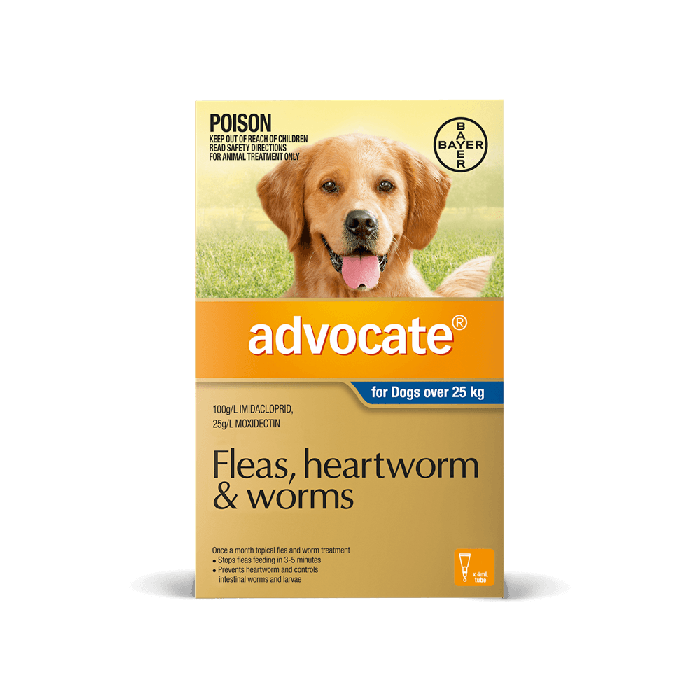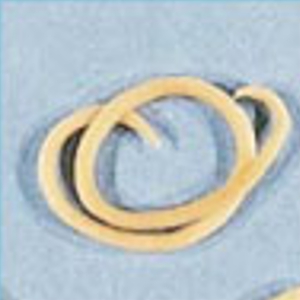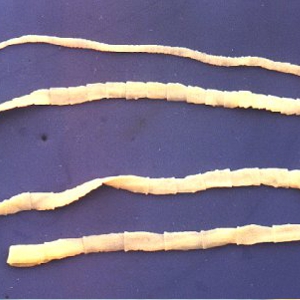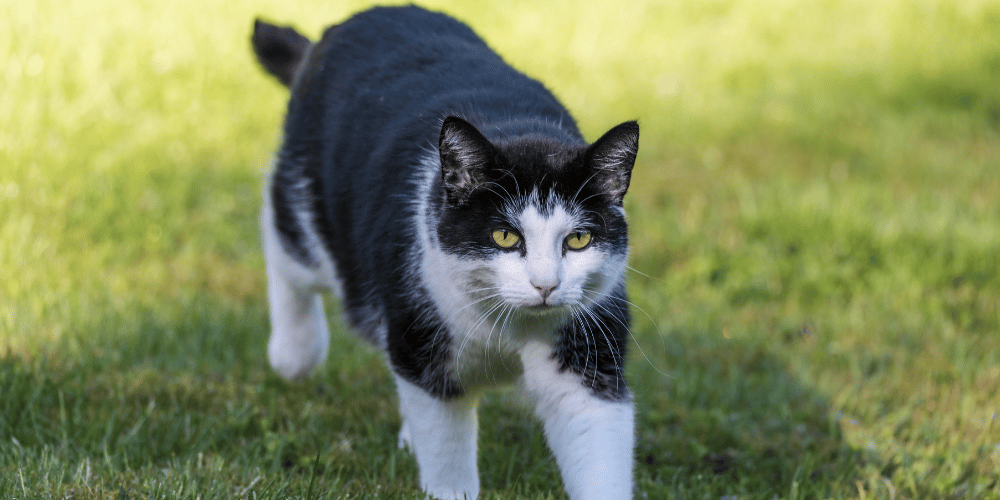
We all know worms in our pets are bad, that's what we have been told in TV advertisements, by our vets and animal carers, by breeders, and many others. But do you know yourself the different kinds of worms and the true adverse effect they can have on our pets? In this article, we will try and shed some light on the different worm types, how to recognize them, and the treatment available.
There is one golden rule with dog and cat worms, prevention is far, far, far better than cure. If you are using well-known worming prevention your dog or cat is in a much safer place than without medication. Be aware though that not all worming preventions cover all the different worm types. For example, Advocate for dogs covers fleas, flea larvae, flea allergy dermatitis, heartworm, roundworm, hookworm, whipworm, sarcoptic mange, ear mites, and lice. Impressive, right? But what about the common tapeworm? While Bayer has this covered by offering Drontal which does cover tapeworm, (as well as a host of other intestinal worms), it can easily be overlooked by you and I.
 The person to talk to about your pet and their prevention treatment is your vet. Their advice goes beyond the best products available for your pet, their advice also takes into account the area where you live and the parasites who also make your friendly neighborhood home. Often this can be done with a simple no-cost phone call.
The person to talk to about your pet and their prevention treatment is your vet. Their advice goes beyond the best products available for your pet, their advice also takes into account the area where you live and the parasites who also make your friendly neighborhood home. Often this can be done with a simple no-cost phone call.
How To Identify Roundworms
Normally there are no obvious signs that your pet may have Roundworms, or Toxocara Canis, Toxascaris leonina. Some possible symptoms are...
- Swollen or bloated stomach
- Diarrhea and vomiting
- Dull or lackluster coat
- Unexplained weight loss or poor growth
Roundworms are white and can grow up to 17.5cm long. They look like thin noodles! You will most likely see them in your pet's feces or vomit. They are normally diagnosed by a microscopic fecal examination.
 Roundworms are the most common worms found in dogs, and can be most difficult to find in puppies who get infected from their mother's milk, or even while still in the uterus. Infection can also occur if dogs eat or handle contaminated rodents. Playing on contaminated soil can be another source too.
Roundworms are the most common worms found in dogs, and can be most difficult to find in puppies who get infected from their mother's milk, or even while still in the uterus. Infection can also occur if dogs eat or handle contaminated rodents. Playing on contaminated soil can be another source too.
It is important to deworm puppies regularly after birth and for the first 3 months. Deworm mothers prior to giving birth to puppies, will greatly reduce the chance of puppies being born with roundworm. For total protection make sure you deworm your dog and young puppy monthly or according to the directions on your chosen worming preventative.
How To Identify Tapeworms
Like Roundworms, Tapeworms, (Cestodes), can be difficult to detect. Keep an eye out for the following symptoms...
- Abdominal pains
- Seems agitated for no reason
- Weight loss or no weight gain
- Itching around the anus
- Vomiting or diarrhea
These nasty little worms are often found broken in pieces, in your dog's faeces or in their vomit. Tapeworms have a rice-like appearance and are often still moving when found. It's most likely you would see them around your dog's anus or in their bedding.
 The usual way your pet will be infected by these worms is thru swallowing infected fleas. If you suspect tapeworms then treat any initial infestation with an appropriate tapeworm medication such as Drontal. Check with your Vet if in any doubt. Make sure you deworm your puppies, kittens, dogs and cats regularly and treat your pets for fleas. Use a product that is well known and trusted, always look for an APVMA approval number to be sure you are buying a genuine product. Remember that most flea and worming meds are based on your pets weight. Always err on the side of caution and go over their weight with your dosage, not under. Going slightly over the recommended dosage will not harm them, while going under will risk not doing the intended job. Finally, ensure to minimize the chances of your dog or cat getting hold of prey animals as they are a source for reinfection.
The usual way your pet will be infected by these worms is thru swallowing infected fleas. If you suspect tapeworms then treat any initial infestation with an appropriate tapeworm medication such as Drontal. Check with your Vet if in any doubt. Make sure you deworm your puppies, kittens, dogs and cats regularly and treat your pets for fleas. Use a product that is well known and trusted, always look for an APVMA approval number to be sure you are buying a genuine product. Remember that most flea and worming meds are based on your pets weight. Always err on the side of caution and go over their weight with your dosage, not under. Going slightly over the recommended dosage will not harm them, while going under will risk not doing the intended job. Finally, ensure to minimize the chances of your dog or cat getting hold of prey animals as they are a source for reinfection.
How To Identify Hookworms
If Hookworms are not treated the effects can be devastating, often resulting in death. Identifying an infestation early is extremely important. Look out for...
- Anemia
- Unexplained weight loss
- Blood in their stool or tarry like diarrhea
- No energy
- Poor growth in younger dogs
- Pale gums
- Irritated skin
You cannot see hookworms with the naked eye, they can only be identified under a microscope usually from a stool sample your Vet will ask for. You will see no evidence of them in your pets stool or vomit. If you suspect Hookworm see your Vet as soon as possible.
Hookworms can be transmitted from a mother to puppy or kitten before birth or after via mums milk, or by exposure to other infected animals including prey. They can also be present in other animals faeces found in parklands and dog parks. Again, ensure to deworm puppies from birth according to the manufacturers label. Use a monthly prevention med and ensure bedding and housing area's are kept clean.
How To Identify Whipworms
Whipworms, (Trichuris vulpis), are like Hookworms - very hard to identify and nasty little things. Symptoms that your dog may be infected with Whipworms can be...
- Weight loss
- Diarrhea
- Anemia
- More than normal flatulence
- Lack of energy
- Stools with blood or mucus in them
Again, you can't see a whipworm with the naked eye, they are identified under a microscope from a stool sample. Transmission can be from a mother to her puppies from before birth to infection from her milk. Exposure to other animals, parklands and dog parks is also common. As always prevention is the best cure, especially with whipworm. Once infected you will find that effective drugs are limited and you will need to speak to your vet regarding treatment. A good way to help avoid infection, apart from a preventive monthly pet med, is to keep your pets living, feeding and sleeping areas clean and dry. Whipworm eggs dry out easily, so the less moisture in your pets environment the better.
How To Identify Heartworm
We've saved what we consider the worse worm to last - Heartworm, (Diflofilaria immitis), potentially fatal if not diagnosed or treated. Before beginning any form of Heartworm prevention ensure your dog is heartworm-free first by visiting a Vet. Some preventive treatments can cause harm to pets if heartworm is already present. Look for the following signs that your dog may have heartworm...
- Swollen tummy caused by excess fluid in the abdominal cavity
- Dull lack lustre coat
- Coughing and/ or laboured breathing
- Spitting or coughing up blood
- Skin blue or purplish
- Fainting
- Bleeding from the nose
- Puppies that don't grow
- No energy, don't like walking or exercise
If your dog is an active breed you will notice signs faster than a dog that is naturally inactive. Inactive breeds may show little signs of infection at all. Heartworms cannot be seen by the naked eye, and the symptoms we listed above typically are seen in the advanced stages of infestation. Heartworms present a huge danger to your pet and your primary goal should be prevention at all times by using a proven and effective Heartworm Prevention.
Heartworms are spread by mosquitoes and occur mostly in warmer areas. There are ways you can reduce the risk in addition to preventative medication, get rid of mozzies from living areas and where your pet sleeps, treat your back yard with pest control. Ensure you begin heartworm prevention from around 6 to 8 weeks of age, talk to your vet about this and the best prevention to use taking into account other treatments for fleas, worms and where you live. Always use monthly heartworm prevention and a brand recommended by your vet. There are a few pet meds around, you need one that is suited to your breed. And lastly, have your vet conduct a yearly heartworm test, usually, this can happen at the same time as your pet's routine visit.
Regular worming of your pet isn't just for their health. It's also to protect you and your family because, make no mistake, just as your pet can become infected from their surroundings they can also pass worms onto humans. If your worse fears come true and your pet is diagnosed with any type of worms then you too should see your family GP as soon as possible. Just to be sure!

